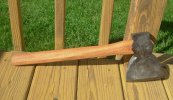- Joined
- Nov 16, 2020
- Messages
- 120
A chapter in axe history everyone is interested in. A thread specifically for this type of handle with photos of original old examples and period literature scans.
I was introduced to octagon cross-section handles a few decades ago when I picked up an old double-bit the widow of it's original owner had stuck between wall joists at a garage sale. In the following years of picking up many dozens of axes and hatchets only locally and in "the wild", I found that old examples of octagon-handled axes were very scarce compared to the common oval cross-section handles. My guess is that getting the octagon shape into the handle requires more expense and may not be something that can be mass-produced with common handle lathes and manufacturing methods post WWII, so they died out along with cheap labor in the baby-boom era.
The most common octagon handles back in the "old days" around and before WWII are the straight handles usually put onto double-bit axes;
Although I have found "S" form handles with an octagon shape such as on this 1930s Craftsman hatchet, so both straight and "S" form handles were known and existed in the old days.;
My hope is to add some old literature scans and more photos of original examples in the near future.
I was introduced to octagon cross-section handles a few decades ago when I picked up an old double-bit the widow of it's original owner had stuck between wall joists at a garage sale. In the following years of picking up many dozens of axes and hatchets only locally and in "the wild", I found that old examples of octagon-handled axes were very scarce compared to the common oval cross-section handles. My guess is that getting the octagon shape into the handle requires more expense and may not be something that can be mass-produced with common handle lathes and manufacturing methods post WWII, so they died out along with cheap labor in the baby-boom era.
The most common octagon handles back in the "old days" around and before WWII are the straight handles usually put onto double-bit axes;
Although I have found "S" form handles with an octagon shape such as on this 1930s Craftsman hatchet, so both straight and "S" form handles were known and existed in the old days.;
My hope is to add some old literature scans and more photos of original examples in the near future.















